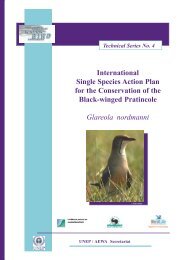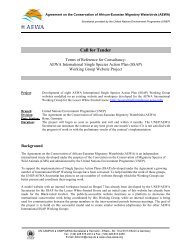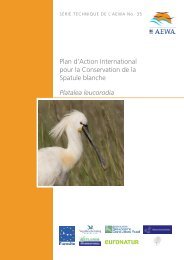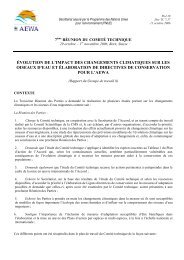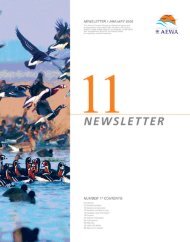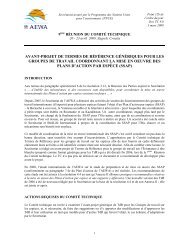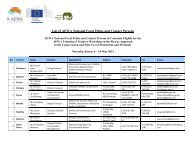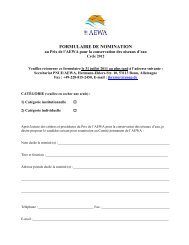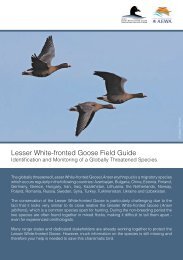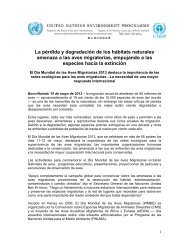International Single Species Action Plan for the ... - AEWA
International Single Species Action Plan for the ... - AEWA
International Single Species Action Plan for the ... - AEWA
You also want an ePaper? Increase the reach of your titles
YUMPU automatically turns print PDFs into web optimized ePapers that Google loves.
<strong>AEWA</strong> Technical Series No. 36 - Annexes<br />
Particular attention shall be paid to mortality due to hunting and urgent targeted<br />
measures should be implemented to reduce <strong>the</strong> magnitude of this threat, <strong>the</strong> success of<br />
which shall be promptly and regularly reviewed and evaluated. Supplementation with<br />
captive-bred birds should be considered if o<strong>the</strong>r conservation measures are not as quickly<br />
efficient as needed and should populations continue to decline. As with any o<strong>the</strong>r captive<br />
breeding, reintroduction or supplementation initiatives this project will be subject to<br />
consideration by <strong>the</strong> Committee <strong>for</strong> LWfG captive breeding, reintroduction and<br />
supplementation in Fennoscandia (see conclusion 3 below). The efficiency of<br />
conservation measures is to be assessed by <strong>the</strong> <strong>International</strong> LWfG Working Group (see<br />
conclusion 2 below).<br />
2. The parties agree that an <strong>International</strong> LWfG Working Group should be established,<br />
consisting of governmental representatives of all Range States, who would be free to<br />
bring in <strong>the</strong>ir own experts and use <strong>the</strong>ir support. The group will be chaired by <strong>the</strong> <strong>AEWA</strong><br />
Secretariat (efficient chairmanship would be possible only if additional support staff<br />
(coordinator <strong>for</strong> <strong>the</strong> SSAP) and supplementary budget are made available to <strong>the</strong><br />
Secretariat) and will operate in accordance with ToR developed by <strong>the</strong> <strong>AEWA</strong><br />
Secretariat, approved by <strong>the</strong> Range states and endorsed by <strong>the</strong> <strong>AEWA</strong> Technical<br />
Committee.<br />
3. The parties agree on <strong>the</strong> establishment of a Committee <strong>for</strong> LWfG captive breeding,<br />
reintroduction and supplementation in Fennoscandia, consisting of governmental<br />
representatives of Sweden, Finland, and Norway, who would be free to bring in <strong>the</strong>ir<br />
own experts and use <strong>the</strong>ir support. The Committee will be chaired by <strong>the</strong> <strong>AEWA</strong><br />
Secretariat (efficient chairmanship would be possible only if additional support staff<br />
(coordinator <strong>for</strong> <strong>the</strong> SSAP) and supplementary budget are made available to <strong>the</strong><br />
Secretariat) and will operate in accordance with ToR developed by <strong>the</strong> <strong>AEWA</strong><br />
Secretariat, approved by <strong>the</strong> three states and endorsed by <strong>the</strong> <strong>AEWA</strong> Technical<br />
Committee.<br />
4. The parties agree that a captive stock of wild Fennoscandian birds should be established,<br />
subject to <strong>the</strong> conclusions of a feasibility study. The long-term future of all captive<br />
breeding programmes will be reviewed by <strong>the</strong> Committee <strong>for</strong> LWfG captive breeding,<br />
reintroduction and supplementation in Fennoscandia.<br />
5. The parties agree that <strong>the</strong> Swedish captive breeding programme could carry on as long as<br />
it is based on wild birds only. The long-term future of all captive breeding programmes<br />
will be reviewed by <strong>the</strong> Committee <strong>for</strong> LWfG captive breeding, reintroduction and<br />
supplementation in Fennoscandia.<br />
6. The parties agree that <strong>the</strong> current free-flying flock, breeding in Sweden and wintering in<br />
<strong>the</strong> Ne<strong>the</strong>rlands, will remain in <strong>the</strong> wild, subject to genetic screening and refinement, i.e.<br />
removal of apparent hybrids, which will be undertaken following <strong>the</strong> conclusion of a<br />
feasibility study. Fur<strong>the</strong>r on <strong>the</strong> dilution with purebred birds is considered a principally<br />
viable option. The long-term future of all reintroduction and supplementation<br />
programmes will be reviewed by <strong>the</strong> Committee <strong>for</strong> LWfG captive breeding,<br />
reintroduction and supplementation in Fennoscandia taking full account of, amongst<br />
o<strong>the</strong>rs, <strong>the</strong> success of conservation actions, including revival of <strong>the</strong> wild Fennoscandian<br />
population, and o<strong>the</strong>r pertinent factors. Decisions regarding <strong>the</strong> Swedish free-flying<br />
population should also take into account <strong>the</strong> conclusions of <strong>the</strong> independent review and<br />
evaluation of available LWfG genetic studies (see conclusion 8 below).<br />
7. The parties agree that <strong>the</strong> implementation of <strong>the</strong> pilot experimental project of <strong>the</strong> NGO<br />
“Aktion Zwerggans” will be postponed by three years. As with any o<strong>the</strong>r captive<br />
breeding, supplementation or reintroduction initiatives this project will be subject to<br />
<strong>International</strong> <strong>Single</strong> <strong>Species</strong> <strong>Action</strong> <strong>Plan</strong> Lesser White-fronted Goose –Annexes<br />
LVII



